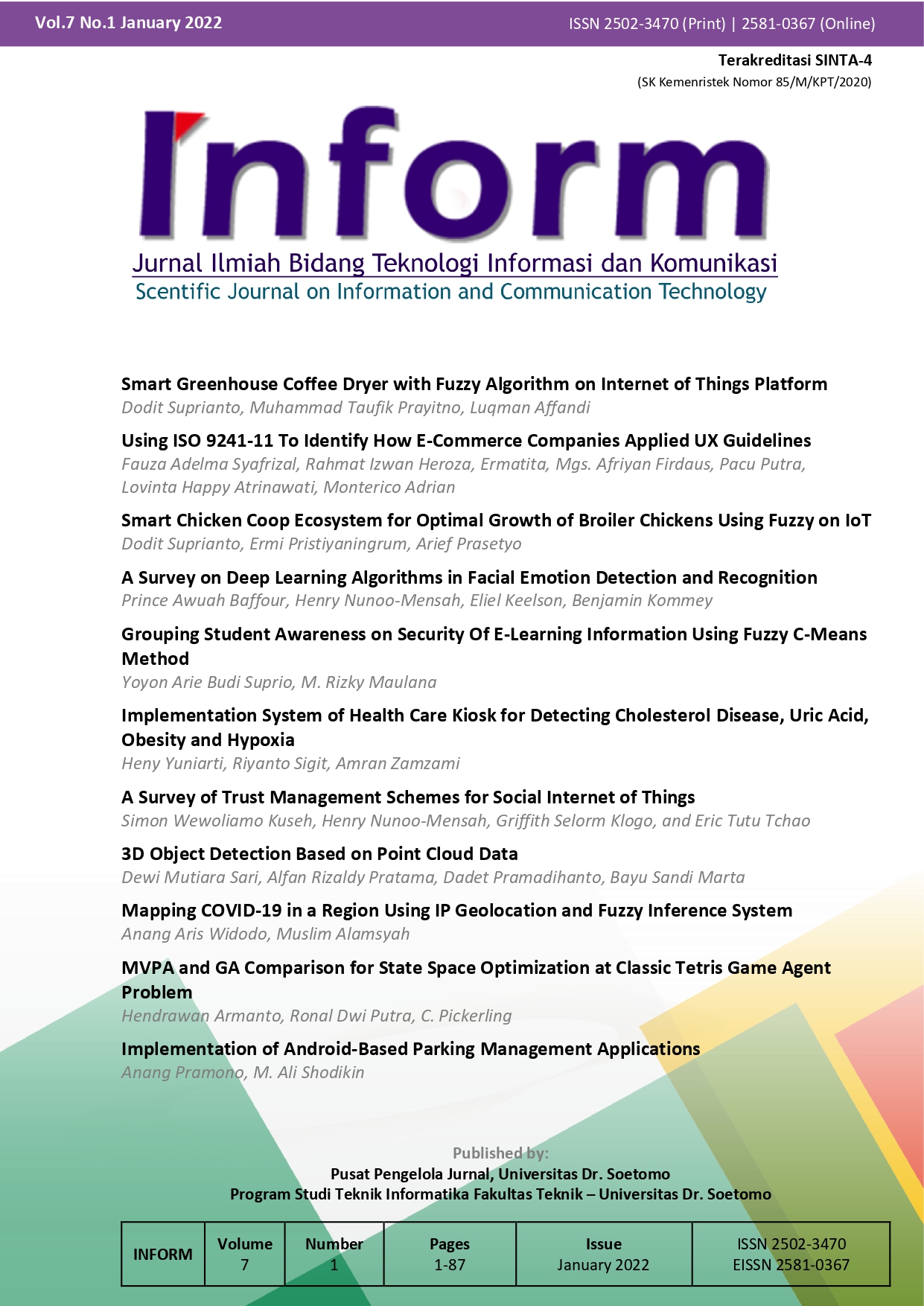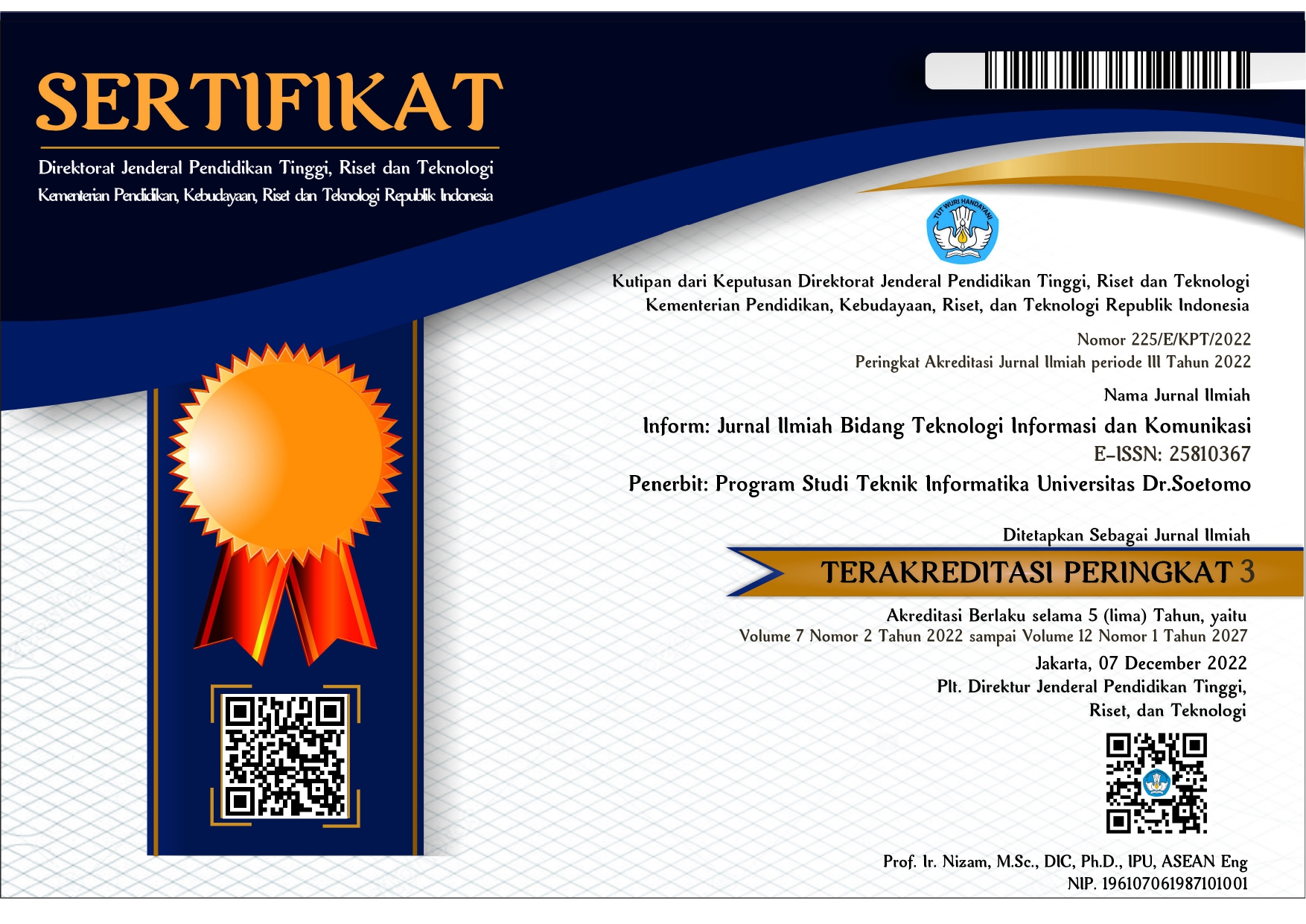3D Object Detection Based on Point Cloud Data
 Abstract views: 334
,
Abstract views: 334
,
 PDF downloads: 260
PDF downloads: 260
Abstract
In the Industrial robotic, computer vision is an important part of the system. The popular object used in the industrial field is a 3D pipe. The problem that is currently being developed is how to detect an object. This research aims to estimate the object detection that is, in this case, is a 3D pipe in various lighting conditions. The camera used in this research is Time of Flight. The methods applied are Remove NaN data for Pre-processing, Random Sample Consensus (RANSAC) for Segmentation, Euclidean Distance for Clustering, and Viewpoint Feature Histogram (VFH) for the object detection. A study conducted on five different objects found that the system could detect each one with a success rate of 100% for the first object, 98.05 percent for the second object, 93.97 percent for the third object, 94 percent for the fourth object, and 99.48 percent for the fifth object. Overall, the system's accuracy in detecting the object is 97.1 percent when four different lighting conditions are applied to five different objects in total.
References
Hsu, C.-Y., Kang, L.-W., You, T.-Y., & Jhong, W.-C., "Vision-Based Automatic Identification Tracking of Steel Products for Intelligent Steel Manufacturing", IEEE International Symposium on Multimedia (ISM), 2017.
Adamo, F., Attivissimo, F., Di Nisio, A., & Savino, M., "An online defects inspection system for satin glass based on machine vision", IEEE Instrumentation and Measurement Technology Conference, 2009.
Kim, J., Lee, M., Yoo, K., Barajas, L. G., & Menassa, R., "3D visual perception system for bin picking in automotive sub-assembly automation", IEEE International Conference on Automation Science and Engineering (CASE), 2012.
Hsu, C.-Y., Kang, L.-W., You, T.-Y., & Jhong, W.-C., "Vision-Based Automatic Identification Tracking of Steel Products for Intelligent Steel Manufacturing", IEEE International Symposium on Multimedia (ISM), 2017.
Bahaghighat, M., Mirfattahi, M., Akbari, L., & Babaie, M., "Designing quality control system based on vision inspection in pharmaceutical product lines", International Conference on Computing, Mathematics and Engineering Technologies (iCoMET), 2018.
6. He, Ying & Liang, Bin & Yang, Jun & Li, Shunzhi & He, Jin., "An Iterative Closest Points Algorithm for Registration of 3D Laser Scanner Point Clouds with Geometric Features", Sensors. 17. 1862. 10.3390/s17081862., 2017.
Aranjuelo N, et al. "Robust 3D Object from LiDAR Point Cloud Data with Spatial Information Aggregation", DOI : 10.1007/978-3-030-57802-2_78, 2021.
Ringbeck, Dr.-Ing. Thorsten, "A 3 D TIME OF FLIGHT CAMERA FOR OBJECT DETECTION", 2007.
Kuo, H.-Y., Su, H.-R., Lai, S.-H., & Wu, C.-C., "3D object detection and pose estimation from depth image for robotic bin picking", IEEE International Conference on Automation Science and Engineering (CASE), 2014.
Han, Xian-Feng & Jin, Jesse & Xie, Juan & Wang, Ming-Jie & Jiang, Wei." A comprehensive review of 3D point cloud descriptors", 2018.
Chen, Chin-Sheng, Po-Chun Chen and Chih-Ming Hsu., "Three-Dimensional Object Recognition and Registration for Robotic Grasping Systems Using a Modified Viewpoint Feature Histogram.", Sensors (Basel, Switzerland) 16, 2016.
Wang, Fei & Liang, Chen & Ru, Changlei & Cheng, Hongtai., "The Iterative Closest Point Registration Algorithm Based on the Normal Distribution Transformation", 2018.
F. Wang, et al, "An Improved Point Cloud Descriptor for Vision Based Robotic Grasping System", 2019, DOI : 10.3390/s19102225.
Copyright (c) 2022 dewi sari, Alfan Rizaldy Pratama, Dadet Pramadihanto, Bayu Sandi Marta

This work is licensed under a Creative Commons Attribution-ShareAlike 4.0 International License.
Authors who publish with Inform: Jurnal Ilmiah Bidang Teknologi Informasi dan Komunikasi agree to the following terms:
-
Authors retain copyright and grant the journal right of first publication with the work simultaneously licensed under a Creative Commons Attribution License (CC BY-SA 4.0) that allows others to share the work with an acknowledgment of the work's authorship and initial publication in this journal.
-
Authors are able to enter into separate, additional contractual arrangements for the non-exclusive distribution of the journal's published version of the work (e.g., post it to an institutional repository or publish it in a book), with an acknowledgment of its initial publication in this journal.
-
Authors are permitted and encouraged to post their work online (e.g., in institutional repositories or on their website) prior to and during the submission process, as it can lead to productive exchanges, as well as earlier and greater citation of published work.













